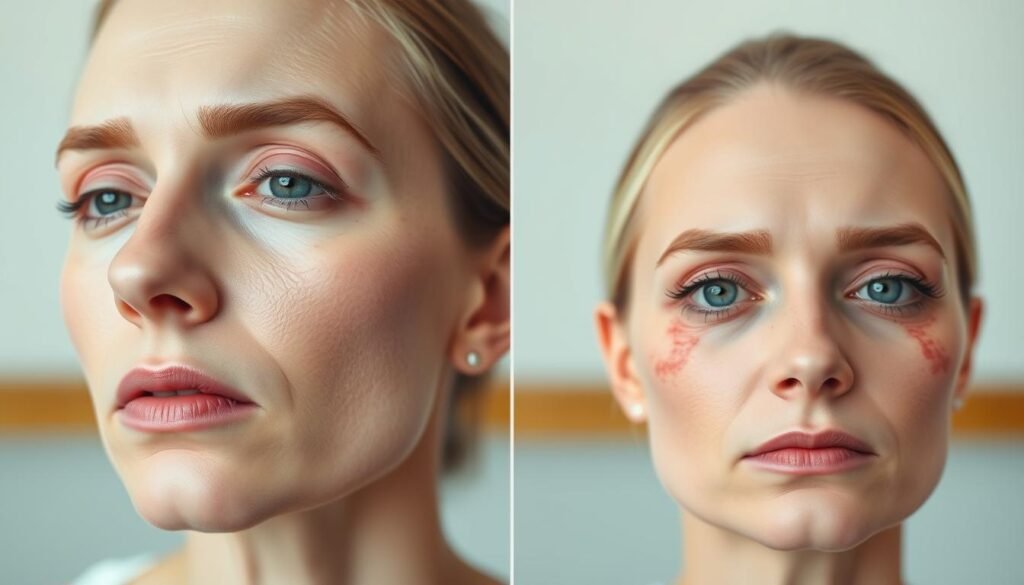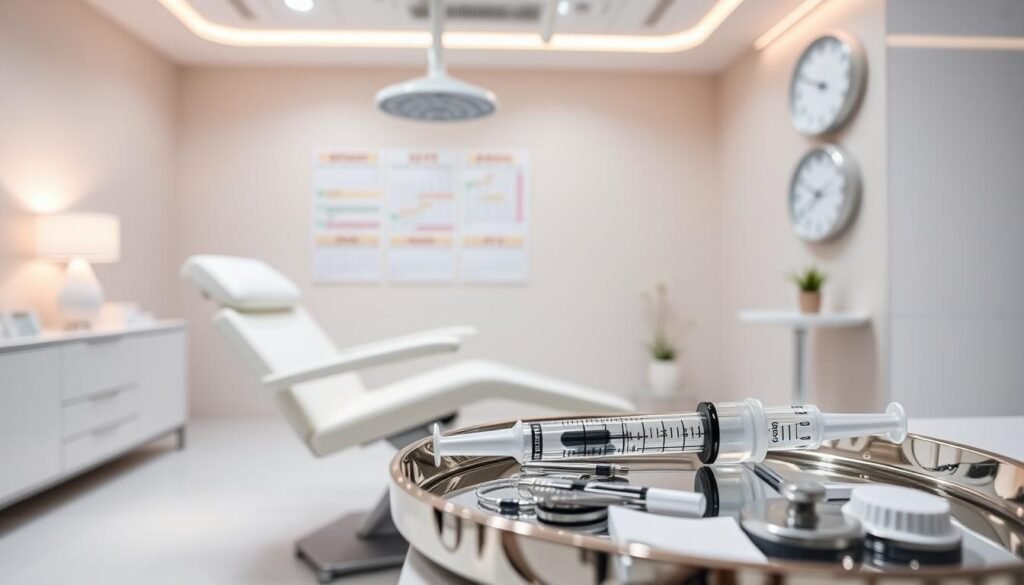Every year, around 7 million Botox treatments happen in the U.S. People want Botox for looking younger and for health issues like migraines. But after getting Botox, many wonder: how long does Botox fatigue last? Knowing what to expect after your Botox treatment is key. This includes understanding side effects and how to take care of yourself after.
Key Takeaways
- Botox fatigue duration can vary from person to person.
- Common side effects may include mild fatigue, soreness, and temporary swelling.
- Monitoring side effects is crucial for ensuring a smooth recovery process.
- Aftercare tips can help reduce overall discomfort following treatment.
- Consult with a practitioner if symptoms persist beyond the expected timeframe.
Understanding Botox and Its Uses
Botox comes from botulinum toxin, a very pure protein. It mainly helps reduce wrinkles, making skin look smoother. But, Botox is also used for medical problems like too much sweating, constant migraines, and an overactive bladder.
Every year, around three million Botox injections are given worldwide. This shows how popular it is for rejuvenation. With so many botulinum toxin applications, it’s key for people to know how it can better their lives. Of course, they should also think about any side effects.
Some might notice mild bruising, affecting about 11% to 25% of people, or headaches lasting a few weeks. While serious side effects are uncommon, learning about Botox helps patients balance the good against the possible bad.
Botox has an excellent safety record with many positive results. It offers help for those seeking beauty and health benefits. If interested in Botox, talking to a skilled doctor is important. They can help create the best plan for you.
What to Expect After Botox Treatment
After Botox, many want to know what comes next. They look for info on care and results. Not touching the treated spots for 24 hours is key. It stops the Botox from moving and causing issues.
Botox changes show up slowly. You might see some improvement in 3-7 days. Yet, wait up to two weeks for full results. Knowing this can make the wait easier.
Drinking plenty of water is important for Botox aftercare. It helps with healing and makes the results look better. Following aftercare advice from your doctor is also vital. It ensures you get the best out of your Botox treatment.
Every person’s reaction to Botox can be different. Some might have small side effects, others feel nothing. Knowing about aftercare can make your Botox journey smoother and more pleasant.
For more health tips, click here.
How Long Does Botox Fatigue Last?
Understanding how long Botox fatigue lasts requires looking at different factors. These factors impact how a person feels after getting Botox. Botox fatigue usually eases in a few days to a couple of weeks. How long and intense the Botox fatigue symptoms are can change a lot from person to person.
Typical Duration of Fatigue Symptoms
For many, fatigue symptoms after Botox start to lessen soon after treatment. It could take a few days to two weeks for symptoms to fade. Patients should watch how they feel during this time. This helps them see how they get better and return to their normal lives. Knowing how long Botox fatigue lasts helps set the right expectations for recovery.
Factors Affecting the Duration of Fatigue
What affects how long the fatigue lasts? Here are some factors:
- Dosage: More Botox might mean more fatigue.
- Sensitivity to the toxin: People react differently to Botox, which changes how fast fatigue goes away.
- Post-treatment activities: Hard activities right after getting Botox can make fatigue worse.
Botox might make you feel tired for a little while. But knowing how long it lasts and what affects it helps people get ready for recovery. This makes getting back to everyday life easier.
Common Botox Side Effects
Knowing about side effects is key for those thinking about Botox. Many handle the treatment well. But, it’s important to watch for common Botox side effects. Spotting these early means quick chats with your doctor, keeping you safe.
Non-Fatigue Related Side Effects
After Botox, some might feel headaches or weakness where they were injected. Bruising and feeling like you have the flu are also common. About 9.2% of people get these flu-like signs. Other issues include upset stomach, nausea, and constipation, hitting 1 to 10% of those treated. Droopy eyelids may happen too if the Botox moves, but this usually gets better in four to six weeks.
Long-Term Side Effects to Watch For
Most people only have mild problems from Botox. But, it’s good to know about serious Botox long-term effects. Rarely, some might have an allergic reaction. This can show as a rash, itching, or swelling. A rare concern is trouble urinating. Telling your doctor early helps manage these issues.

For more on common Botox side effects, talk to your healthcare provider. Knowing what might happen and talking openly can help make your Botox experience a success.
Managing Botox Side Effects Effectively
Knowing how to deal with Botox side effects is key for those who use it. It makes recovery smoother. Many worry about feeling tired or other issues after Botox. There are steps to take to ease discomfort. Knowing when to get help is also important.
Tips for Reducing Fatigue
Here are ways to fight off tiredness after Botox:
- Stay Hydrated: Drinking water helps with recovery and may ease tiredness.
- Rest Adequately: Getting enough sleep boosts energy and cuts down on feeling tired.
- Minimize Strenuous Activities: Avoiding hard workouts or tasks right after treatment helps with symptom management and prevents making things worse.
- Ice Packs: Using ice packs on the treated areas might lessen swelling and bruises, making healing faster and indirectly combat fatigue.
These actions can help handle side effects and reduce the chance of lasting discomfort. To aid recovery, one can try natural therapies like yoga or meditation.
When to Contact Your Practitioner
It’s critical to watch your health after Botox. Sometimes, it’s necessary to reach out to a practitioner:
- Experiencing prolonged or worsening fatigue
- Seeing severe swelling or bruising unexpectedly
- Having flu-like symptoms weeks after treatment
Contacting a healthcare provider is crucial for the right care when needed. Keep in touch with your practitioner to stay safe and well-informed during your beauty treatment. Always remember, safety comes first, so contact the practitioner with any concerns right away.
Botox Treatment Duration and Procedure Timeline
Understanding the Botox injection process is key for patients getting ready for it. The whole procedure is simple and takes just 10 to 15 minutes for the injections. Before this, there’s an initial meeting. It’s where patients can talk about what they hope to achieve, their expectations, and any worries they have.
The whole Botox journey, from the first consultation to follow-up visits, can vary in time. After the first treatment, patients may start seeing results in a few days. The peak effects show around two weeks. These effects last from 3 to 6 months. So, regular treatments are needed to keep up the results. As time goes by, some may notice they need treatments less often. They might only need to return every 9 months or even a year as their muscles weaken over time.
Several factors can influence how long Botox effects last. These include how each person responds and their lifestyle choices. Adding zinc supplements and staying hydrated could improve the outcomes. It’s also important to manage sun exposure, and exercise, and follow aftercare tips to ensure the success of the botox injections.

| Stage | Duration |
|---|---|
| Initial Consultation | 30-60 minutes |
| Injection Process | 10-15 minutes |
| Post-Injection Observation | 15-30 minutes (optional) |
| Results Visible | 3-14 days |
| Duration of Effects | 3-6 months |
| Possible Follow-Up | 1-2 weeks post-treatment |
Post Botox Aftercare Tips
After you get Botox, how you care for yourself is key to good results. Following special advice helps manage muscle weakness that might happen. These tips will make recovery smoother.
Aftercare for Managing Muscle Weakness
If you feel muscle weakness after Botox, follow these steps to get better:
- Don’t lie down for four hours after the shots. This keeps the toxin from moving to places it shouldn’t.
- Stay upright right after your injection. It helps the Botox stay in the right spot.
- Don’t rub or massage the areas that were treated. This stops the toxin from spreading where it’s not supposed to go.
- If muscle weakness doesn’t go away, talk to a doctor for advice on what to do next.
Recommended Activities and Avoidances
What you do after Botox can really affect your results. Following these tips will help you recover better:
- Don’t do hard workouts for 24 hours. It can raise your blood pressure and make you sweat, which is not good for the treatment.
- Avoid putting on makeup the day you get treated, and the day after. This lowers the chance of getting the injection spots dirty.
- Stay away from alcohol for at least 24 hours to keep bruising down.
- Keep out of the sun and heat for 1-2 days. It prevents extra blood flow that can cause bruises.
- Wait at least a week before getting facials or other skin treatments. It lets the Botox settle in right.
Cosmetic Injections Recovery Time
Grasping the cosmetic injections recovery timeline is key for anyone thinking about Botox. Not everyone will have the same downtime. Side effects also vary in how long they last. It helps to know about Botox recovery time for a better healing journey.
Recovery time is usually short after Botox. You can get back to daily tasks right away. Relief from Botox starts to show within a few days. It lasts from 3 to 6 months. To keep the effects, more treatments might be needed.
Some mild side effects are common, though. They include:
- Bruising at the injection site. It tends to go away in 2 to 3 days but sometimes takes longer.
- A flu-like feeling. This usually doesn’t last more than 24 hours.
- Headaches or migraines. These can last a few hours or up to several days.
- Gastrointestinal issues like nausea. This can last a few days to a couple of weeks.
- Dry mouth. This might stick around for up to 5 days. Drinking water helps.
Before getting injections, you should stop certain meds. For example, blood thinners and alcohol. This reduces bruising and other problems. Side effects tend to be mild but watch them, especially if they last a while.
With expert advice and knowing the cosmetic injections recovery process, you can handle your recovery well.

Botulinum Toxin Fatigue Symptoms
If you’re thinking about getting botulinum toxin treatment, knowing the signs of fatigue is key. People often feel tired or slow after their injections. Spotting these signs early can help you handle the side effects better.
Identifying Fatigue Symptoms
After getting botulinum toxin shots, you might feel slightly to very tired. Key identifying symptoms include:
- Feeling tired all day
- Muscle weakness, especially where you got the shot
- Feeling sleepy or having less energy
Feeling a bit tired is expected, but you need to pay attention. If your tiredness gets worse or if you see other strange symptoms, you should get medical advice.
Differences Between Normal and Unusual Symptoms
Knowing what’s normal and what’s not helps decide when to see a doctor. Normal signs might be a little discomfort or weakness. On the other hand, signs that need a doctor’s look include:
| Normal Symptoms | Unusual Symptoms |
|---|---|
| Mild tiredness | Severe, ongoing fatigue |
| General weakness | Major muscle weakness that stops daily tasks |
| Short-term drowsiness | Confusion or losing track of where you are |
Patients should keep track of how they feel and see a healthcare provider if needed. For deep insights on how botulinum toxin injections work, check out this literature review.
Conclusion
Understanding Botox treatment is crucial for anyone considering it. This guide highlights that Botox fatigue can last a few days to weeks. It varies by person. Patients must know the side effects and how to handle them.
Communication with healthcare providers is key during Botox treatment. It’s important to discuss any flu-like symptoms or lasting side effects quickly. Proper care and follow-up reduce the risk of problems.
Patients feel more in control when they know about Botox. For details on flu-like symptoms from Botox, check out this informative guide. Being informed helps ensure a positive experience with Botox and self-care.